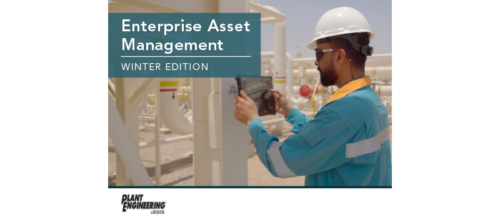Checking the pulse of the CMMS/EAM industry at the National Plant Engineering Show
Trade shows aren't necessarily the best indicator of where an industry is heading. After all, they basically present what the marketing and sales folks want you to see. Their direct message is always going to be upbeat, with wonderful new advances and opportunities galore. But they still provide an opportunity to see vendors of all stripes under the same roof.
Trade shows aren’t necessarily the best indicator of where an industry is heading. After all, they basically present what the marketing and sales folks want you to see. Their direct message is always going to be upbeat, with wonderful new advances and opportunities galore.
But they still provide an opportunity to see vendors of all stripes under the same roof. If you are willing to wade through all the hype, you should get a good feeling where things are really going.
The internet can provide a wealth of information on CMMS/EAM packages; however, I still think there is value in attending trade events such as the National Plant Engineering MRO and Maintenance Show for prospective buyers and existing users. For buyers, it is still a great place to get hands-on demonstrations and meet with vendors. Both potential and existing users can benefit from seeing the wares of auxiliary service and product providers, such as MRO e-marketplaces, plant automation systems, equipment condition monitoring solutions, and maintenance consultants.
For me, it is a great place to spot industry trends. Vendors put a lot of money into delivering their messages. Strip away the marketing hype and you’ll get a picture of what is really new and/or hot in the CMMS/EAM marketplace.
One clear trend that I keep coming away with from every show is consolidation. Through acquisitions and departures, the number of CMMS/EAM vendors continues to contract. The shrinking number exhibiting at the Plant Engineering Show is a partial indicator that this trend will probably continue.
More telling is the fact that vendors are increasingly chasing the same customer pool. Large Tier 1 solution providers are going after smaller customers. Vendors that used to specialize in well-defined customer types or vertical industries are now trying to be everything to everybody. The marketplace is definitely maturing, and there is a limit to how many vendors it can support.
Any prospect of further industry consolidation didn’t detract from the messages that vendors were providing at the show. I walked away with several messages.
Mobile computing and ASPs are mainstream
Practically every vendor had one or more mobile computing solutions. Even the smaller Tier 2 vendors had plenty of handheld solutions. Most of the handheld products were for paperless work orders, but several vendors had packages for asset tracking and storeroom management.
Solution platforms were evenly split between Windows CE and Palm compatible devices. The former being preferred for its screen resolution, while vendors chose the latter for its installed base and price point.
Application service providers (ASPs), or hosting services, were also a recurring theme at the show. Under the ASP model, vendors are leasing remote access to software instead of shipping licensed software to customers.
Last year, most Tier 1 vendors featured or talked about ASPs as a new concept. This year they were pitching them as a standard delivery vehicle along side their licensed product offerings.
Nowhere was this fact more apparent than at Fluor’s TabWare (tabware.com) booth where their hosted service, TabWare Online, got equal billing with their packaged product, TabWare Onsite. Last year Fluor brought in a Lamborghini to help promote TabWare Online. This year it was just a standard offering.
The Fluor people said that 50% of new customers are opting for TabWare Online. While they admit that this number includes Fluor Global Services facilities management contracts, they maintain that their ASP offering is becoming increasingly popular among independent customers. They are also positioning Online as a solution for small-to-midsize operations that cannot justify the cost of their licensed Onsite product.
This creep of the Tier 1 providers into the Tier 2 market space via the ASP model is not lost on the small CMMS/EAM vendors. Several Tier 2 companies said that they have plans to offer an ASP solution for their product line. I’m not sure how this is going to play out since most Tier 2 providers do not have a systems architecture or cash flow position that is conducive to the ASP model.
We’re more than software vendors
In a maturing marketplace, there is a definite limit to the amount of money that can be made from license and connection fees. So it is only natural that the Tier 1 vendors are turning to other sources to supplement their revenue stream.
Most top vendors were talking about complementary services, including procurement, integration, business intelligence/data mining, training, and operations consulting. When a vendor couldn’t directly supply a particular product or service, they had a partner in the wings to fill the gap.
Datastream’s (datastream.net) audience presentation was a good example of this phenomenon. Datastream announced its new internet portal service, Datastream Network, at the show. It seemed like their presentation was half way over before they got around to mentioning that they had a CMMS/ EAM offering.
Procurement, asset disposition, collaboration, and online training and support were all an integral part of their “Asset Life Cycle Management” theme. While their CMMS/EAM application software still played a prominent role in the presentation, it certainly did not crowd out the other messages.
MRO Software (mrosoftware.com) definitely brought a composite message to its booth. The former PSDI presented their MRO Supply, MAXIMO EAM, Intermat catalog content management, and Applied Image Technology (a recent acquisition) product lines. They advertised numerous business alliances, including i2 Technologies and Ariba, and also had the wireless solution provider Syclo exhibiting in their booth.
Cayenta (cayenta.com) offered a new concept for their Mainsaver EAM called Result Points. Under Result Points, Cayenta works with each client to establish quantifiable performance indicators that are used to benchmark the success of the implementation. Cayenta guarantees its implementation fees against meeting or exceeding these result points.
I’ve seen this concept employed in other software industries, but it was the first time I heard it employed in the CMMS/EAM arena.
Industrial supply chain
Not surprisingly, e-commerce played an important role at the show. While most Tier 1 vendors assiduously avoided the “dot com” term, they were all too happy to talk about how e-procurement fits into their products and services. Optimizing the maintenance, repair, and operations (MRO) supply chain has become a big business in the CMMS/ EAM industry.
Nowhere is this case more apparent than at MRO Software. The company has even changed its name (from PSDI) to prove the point. Its MRO or industrial supply chain solutions get an equal, if not greater, billing than their Maximo EAM product line. Their e-commerce solutions address both sides — supplier and buyer — of the supply chain. While the company still operates its own electronic marketplace, MRO Software is now concentrating on being an “e”-enabler who can do business with any electronic trading exchange.
MRO Software is not alone in this arena. Datastream is aggressively growing its iProcure network and services. Fluor is partnering with Pricing Dynamics to address MRO e-procurement. But I haven’t seen this focus filter down to the Tier 2 CMMS/EAM vendors.
This condition is understandable given the high entry costs required for a CMMS/EAM vendor to play in this world. However, small maintenance operations make up a very significant portion of the MRO supply chain. With the help of maturing technology standards and savvy MRO suppliers, I expect that the more aggressive Tier 2 companies will begin to address the e-procurement sector.
Visibility between trading partners is only part of the industrial supply chain for large corporations. Interplant visibility can be just as important in optimizing MRO inventory levels.
Cayenta addressed this issue at the show with their Mainsaver Interconnect solution. Interconnect provides a real-time, integrated view of inventory across multiple plants. One Mainsaver site can search for parts in other facilities and initiate transfers based on availability. Overall inventory levels can be reduced through information and resource sharing.
Future trends
The show can also be a good indicator of upcoming trends. I spotted several contenders.
-
Partnerships —Alliances aren’t new to the industry, but they are starting to become much tighter with partners reselling and integrating each other’s wares.
-
Business intelligence —Only a small portion of the information contained in a CMMS/EAM is effectively utilized. Business intelligence tools identify and deliver key performance indicators to the right people at the right time.
-
Multiple package integration —Through mergers, more and more corporations find themselves operating multiple CMMS/EAM packages. Standardizing on one package may not be practical. Corporations in this situation will press vendors and integrators to tightly interface different CMMS/EAM packages.
While it may have been a slow show for some vendors, I found my time at NPEM 2001 very profitable. Like past shows, it gave me an industry perspective that I couldn’t obtain elsewhere.
I’m very eager to see how the trends I have mentioned will develop throughout this year and factor into next year’s show.
Tom Singer is an information technology consultant who specializes in designing, developing, and implementing systems solutions that meet client operational needs. He can be contacted at 630-472-1524, or by e-mail at tsinger@tompkinsinc.com .
Do you have experience and expertise with the topics mentioned in this content? You should consider contributing to our CFE Media editorial team and getting the recognition you and your company deserve. Click here to start this process.



